Category: Business
How to improve business efficiency with voice app?
Your company’s apps are losing attention. It’s not 2010 anymore. Simply telling your customers that you have a mobile app doesn’t impress anyone. It’s become a standard expectation. There are more than 2 million apps available for Android in the Google Play store and nearly the same number in the Apple App Store. As your app gets less and less use, your company is more likely to be ignored and your app uninstalled.
Three Traditional Mobile Best Practices That Dull Your Edge
Let’s review what used to work in building engaging mobile apps and why those tactics are no longer enough.
Releasing new features. An app that goes months without updates looks abandoned. So you should push updates for new features and bug fixes regularly. Unfortunately, every mobile app worth its salt is already updating frequently. Simply keeping up is not going to set you apart.
Responding to reviews. Monitoring the reviews end-users leave for your app is a good source of new ideas. Responding directly to end-user feedback by launching fixes is a good idea. It is also a common idea that most other companies have already implemented.
Staying current with security and privacy expectations. Consumer data privacy concerns have never been higher. GDPR (General Data Protection Regulation) in Europe and increasing regulation in the USA (e.g., the California Consumer Privacy Act 2018) means the minimum security standard is going higher. The good news: Apple and Google are doing some of the heavy lifting in mobile app security for you. Fall behind with security and you will lose customers. On the other hand, simply keeping up with security threats and updates will not make you stand out.
If keeping up with those outdated best practices is not enough, what can you do to keep users coming back for more?
Apps That Speak and Listen: Your App Opportunity
Instead of getting lost in the app shuffle, take advantage of the latest developments in voice interaction. Thanks to Apple, Amazon, and Google, we’ve all become used to interacting with technology by speaking. In fact, there are over 100 million smart speakers currently installed in American homes according to an NPR survey. The true number of voice-enabled devices is much larger than that when you factor in mobile devices. Voice interaction with a mobile app gives a new and more intimate customer experience. That’s why you should take advantage of this new capability.
Why does the growth of smart speakers matter for your company’s apps? The popularity of these devices means that you do not have to worry about hardware. You just need to deploy your app to one of those platforms. Voice interactive apps are still new but don’t worry – your company is not going to be the very first.
Before you speak with other executives about launching a voice interactive app, you should have some live examples in hand. Consider Capital One, the financial services company, which launched an Alexa skill (i.e., a voice interactive app made for Amazon’s platform) back in 2016. Other financial companies have since followed their lead. On the Google Home platform, AutoVoice lets you set up tasks and create personalized commands. You can use these apps to control your smart home, order pizza, check your bank balance and more.
How do you jump into the world of voice interaction?
There Are Two Paths To A Talking and Listening App: Which Will You Choose?
There are two ways to join the voice-enabled app revolution. (Hint: One is easier.)
You can either follow the path forged by technology giants like Amazon and Google. Invest heavily in building a top-flight team of developers and launch a testing program. This approach maximizes your control over the app and gives you the most options for integrating it into your systems.
Bear in mind that there are significant downsides to building your app development team internally. Structuring this kind of app development capacity internally takes months if not years and comes at a considerable expense. After all, developers are well paid — PayScale ballparks the median pay for Android developers at $82,000. Quadruple that amount and you will nearly have built your full team.
Working with a custom software development team to build a voice-capable app is a better choice in many cases. Your IT managers set the scope and retain oversight for the project. But there’s no need to use resources for recruiting or training since the team is already in place. By working with Fingent, you will benefit from our expertise in enterprise projects. We’ve collaborated with professional services firms like PwC and technology companies like NEC on development projects. So which path into the voice-enabled app revolution will you choose?
Stay up to date on what's new

Featured Blogs
Stay up to date on
what's new



Talk To Our Experts
Before I give a definite yes or no to this question, let’s understand the concept of User Interface or UI.
Remember back in the days when owning a Gameboy was as good as an Xbox now, when 30 minutes of Super Mario Land was as intense as a game of graphically dense Far Cry 5 today? Or how uber cool it was to hit your favorite music on a Sony Walkman while you browsed through your myspace account?
Fast forward to 2019, where software is more intelligent and much better looking, even the older millennials cannot ditch their Xboxes to go back to the Nintendo DS nor can they return to myspace from Instagram. Did they love their Nintendos? Yes. Did they enjoy using it even though it wasn’t as graphically demanding? Yes. Then what changed?

All thanks to better UI designers.
Related Read: The Power of UX and UI in Delivering Successful Digital Assets
What Is UI?
UI or User Interface is simply the link between your customer and your product. Whatever elements your customer can see, touch or feel to navigate through your product can contribute to the User Interface. Be it the mobile phone we use, the smartwatch we wear, the car we ride or the websites we use. Everything has a User Interface.
Talking about software, do customers really care what your software looks like or do they just want any platform to get their work done quickly?
The answer is Yes. Customers do care about the interface you provide. Are they aware of it? Probably not.
Psychologically, most users aren’t consciously aware of the interface they use to navigate through the software. It is through their experience on your website that they decide whether to stay or leave. This is where the importance of User Experience or UX comes to play. A well thought of User Interface can subsequently lead to good user experience and can undoubtedly help you retain your users.

Here are a few points that you need to keep in mind when you design your next product to help you retain your customers/users.
1. Take Time to Research
This is one of the most underrated steps in the software design process. Many product teams focus on having the requirements in place and getting work started without “wasting” time. Little do we realize that spending those extra hours in user research and understanding the end user, can do wonders for your product.
Nowadays companies even consult with independent UX research companies that conduct user interviews, focus groups, personas, etc. for them. According to Forrester Research, a good user-centric design has proven to boost ROI and bring up conversion rates by up to 400%.
Moreover, in a study by the Design Management Institute, “design-centric” companies outperformed the S&P 500 by 211%.
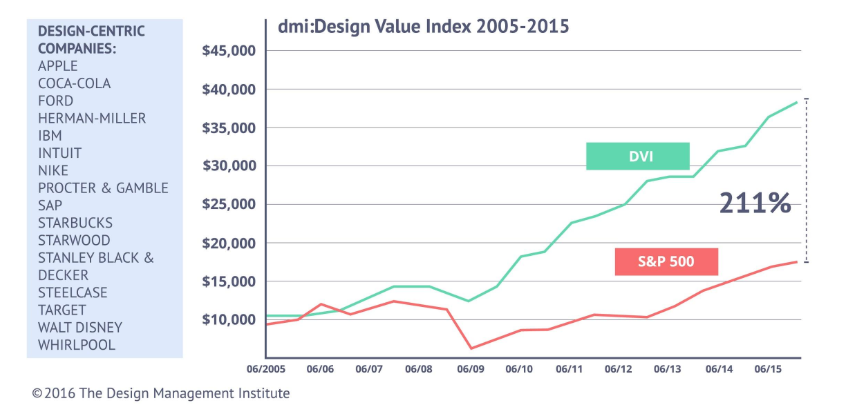
Source – The Design Management Institute
It is imperative that the product that is being delivered to users cater to their needs, accommodate their goals and reflect their behavior in order to make them use your product. A design that does not take into account what the customer wants will only prompt them to move away from your product.
2. Make Educated Decisions
Needless to say, it is absolutely crucial that design teams are aware of the latest trends in software design and are up to date with the current design principles. As a designer, you simply cannot afford to offer a dated solution to your user. So make sure your product team takes that extra step to study what solution your competitors are offering for the same problem and try to come up with a better solution.
This does not mean you need to go over the top with new ideas and designs. For example, a trash can icon is synonymous to “Delete” in the digital world and replacing that with any other fancy icon would only confuse your user.
Some very well thought UI creations that come to my mind are
- Charlie AI
- Samsung SDS Flow
- Airbnb
- Bellroy
- ESPN Sports Programming
3. Use a Style of Communication that Suits Your Audience
Understand your user base and use a communication style that best suits their age and interests. Say for a children’s website or a fashion e-commerce application, a dull downbeat communication style might not sit well with your younger audience and could force your customers to move on to an application they can relate to emotionally.
On the other hand, a professional network like LinkedIn will require a precise and formal tone as the larger audience on it are strictly there for professional reasons.
Using a tone that makes sense to your audience is very important to capture their attention and build trust with them. Users like to know the “people” behind the software and the tone of your website does just that.
4. Consistency is Key
Like we talked about setting a communication style for your website, it is just as important that this style is maintained throughout the website. The importance of being consistent cannot be stressed enough when it comes to optimal user experience. Users tend to use applications that are consistent in their elements, color scheme, typefaces, and interactions.
Say, if your application displays notifications on a side panel, maintain all notifications on the side panel throughout the site. Believe it or not “Your users don’t like surprises”.
5. Include a Knowledge Base
Let’s explain this with an example. Patrick wants to use your application. He loves the concept and the UI design. He can’t wait to start using your app as he has heard it is perfect for his needs. But Patrick has no idea HOW to use your product. He searches for a guide to help him, but found none. Disappointed, he had to move to another application that had a detailed manual.
Now, losing a customer like Patrick is such a shame. Had you spent that extra effort to create a beautifully crafted knowledge base that explains every functionality and feature of your app, you would have retained millions of users like Patrick.
Understand what your users are looking for. If you don’t want to maintain a separate knowledge pile for this, you can add all the information you want to show the user in the UI, by making it seem less like a knowledge base but more like an intuitive design. You could even integrate an AI bot to answer popular queries for you instantly.

When customers are able to find answers to their questions easily and without having to Google/Quora for answers, the overall customer satisfaction increases and also increases user engagement on your website.
Related Read: CTOs Guide – How Robotics and AI Can Improve Customer Experience
6. Less is More Vs More is More
Minimalism isn’t just a fancy word for lazy design. A minimalist design is a visual concept that seeks to embrace simplicity in design, in order to rope in users only towards what is most important.
When catering to a mature target audience, minimalism can be more attractive than a page full of creative design elements, sliding panels, glittering headlines, and modish popups. If your aim is to urge your customers to focus on a particular set of products, minimalist design is the path to choose.
However, it is crucial to understand your customers here. A minimalist design may not work as well for software designed for children, like an educational game. Younger audiences probably would not understand the aesthetic that you are trying to create and may move away to a more attractive website.
7. Improvise and Adapt – The Secret Sauce of Software Design
This is probably THE most important point that businesses need to keep in mind in order to retain their user base for years.
According to a survey by Skype, Adobe, Norton, and TomTom, less than half of the technology users do not like to upgrade software when they should. The simple reason is that people are comfortable with the way things work and do not want to risk getting an update until it’s proven to work for someone else.
On the contrary, users are attracted to new features and functionality as well.
So how do we ensure our software stays on top of its game to an audience that are hesitant to upgrade but wants new stuff too?
Let’s look at the case study of a simple messaging software.
Starting with a messaging platform to simply connect with friends and family via text messages, the team introduced push notifications on mobiles to ensure messages are received even when the application is not running in the foreground. Once the application garnered a few users, more features like photo and video sharing were added and while they were at it, some edit and filter features were included too. Once the application turned out to be an indispensable communication tool for its users, they added voice and video call features.
At this point, users were receptive to all these subtle changes because they hadn’t realized that the application as it was in the beginning, had completely transformed into something much bigger. As far as the customers knew, their experience on the application was flawless. Once the users were comfortable with the current working, the team added group conferencing and even payment integration. Finally, what started as a simple one-on-one messaging app had the potential to replace at least 4-5 apps that were needed every day.
This is the story of how the messaging giant “WhatsApp” increased its user base from a humble 250,000 users to more than 1.5 billion active users standing right next to Facebook and YouTube.
Takeaway – Start by building trust with your customers. Be attentive to your customer’s needs and incorporate improvements without overwhelming the users.
Some popular applications that have evolved into tech giants over time are
- Google Suite
- Adobe Photoshop
- Amazon
- Windows
- Android
- SAP
- iOS
Knowing how to improvise and adapt is the reason these intelligent businesses remain relevant in the market for years.
Related Read: How AI is Redefining the Future of Customer Service
Summing Up
Coming back to the beginning of this article, we asked you why millennials are unable to switch back to older technologies even though they enjoyed the UI at that time. Gameboys for one, were well researched, were consistent, came with a detailed manual and had a great design given the technological limitations of that age. Where they failed to deliver was improvisation. Users are always looking for the next big technological breakthrough.
To stay on top of your game, you must be open to enhance your product for improvements and cater to the continuous cycle of changing customer demands. Product teams should focus on providing users with a flawless experience, be it through the user interface, functionality or customer service. A user-friendly UI is a catalyst for building good relationships with your customers. Retaining your users become easy when you have earned their trust by consistently meeting your customer’s expectations.
By building sustainable software that sees well into the future, we at Fingent, believe our partners deserve the best that technology can offer. Feel free to contact our consultants to get an insight into how we work to deliver your dreams.
Stay up to date on what's new

Featured Blogs
Stay up to date on
what's new



Talk To Our Experts
Customer Experience or CX may be the single most important factor that could make or break a business in today’s customer-centric market. A good product, a great marketing team, and competitive pricing can all amount to nothing if the customer experience isn’t up to the mark. As more and more businesses head towards brand transformation, it is vital that they keep the customer experience at the center of things.
In this blog, we will discuss why a memorable Customer Experience is key for brand transformation and how you can achieve it for your business.
How Important is Customer Experience?
Before we get into the importance of customer experience, let’s have a look at what that term really means.
Gartner defines customer experience as “the customer’s perceptions and related feelings caused by the one-off and cumulative effect of interactions with a supplier’s employees, systems, channels or products.”
A take on the definition of what a customer has come to mean today was brought out in this interesting article: “In a connected business reality, everyone in the ecosystem of your business is a customer: from employees and investors to partners, buyers and their networks, including the various players in the value chain from manufacturer to end consumer and back. In other words: all stakeholders.”
Customer Experience then is much more than achieving customer satisfaction. Everything a brand does play a part in forming the customer experience. A study by the Temkin group brought out that CX is made up of three components – success, effort, and emotion. The study showed that out of all the three, emotion played the most significant part. Affecting the emotions of customers through a concerted effort by the brand is what customer experience management is all about. Does it pay off? Definitely. As the study goes on to show, “companies that earn $1 billion annually can expect to earn, on average, an additional $700 million within 3 years of investing in customer experience.”
The benefits of Customer Experience extend to much more than revenue, though that is a pretty great factor in itself! A Walker study found that customer experience will overtake price and product as the key brand differentiator by the year 2020. This is of prime importance in brand transformation as the key goal of this transformation is to differentiate a business from its competitors and get ahead of them.
Related Reading: Find how Robotics and AI can help improve the customer experience
Ways to Enhance the Customer Experience
Ensuring that Customer Experience is the best it can get is a complete discipline in itself. Customer experience management (CEM or CXM) is the function that works towards streamlining every interaction between an organization and its customers. The goal is to foster brand loyalty in customers by ensuring that every touch point in the customer’s journey with the brand is satisfactory. The Customer Experience must be memorable and for the right reasons.
The most important factor in creating a good CX is to have a 360-degree view of customers. Starting from there, the customer’s journey is optimized at every point to ensure a consistently positive experience. Consumer research, a thorough knowledge of market conditions, and an organization’s culture, vision and mission are some factors to keep in mind when designing a customer experience strategy for your business. This will ensure that the strategy takes into account all departments in the organization and not just those in customer-facing roles.
Customer Strategist Journal lists six key areas of the digital customer experience:
-
Reachability
-
Service convenience
-
Purchase convenience
-
Personalization
-
Simplicity and ease of use
-
Channel flexibility
If you notice, many of these key areas are linked to the channels used by customers. The Genesys State of Customer Experience research brings out that 83% of consumers say the ability to move from one assisted channel to another, such as moving from web chat to a live conversation, is desirable. However, only 50% of businesses support such cross-channel interactions. This is definitely something to be considered. Let’s look into this in detail.
Unlike a few years ago where customers would communicate with brands either through email, telephone or directly visiting the company, today’s connected customer has various channels at their disposal. Websites, Facebook, Twitter, Whatsapp, and public forums are being used to contact and interact with brands. They expect customer service to be available and top notch in all these channels. This makes the brand transformation complicated, as delivering flawless customer service through every one of these platforms is challenging to say the least. If you fail, you know they are going to switch brands, which are available at the next click.
Channel Switching is another related challenge. For example, a customer could raise an issue through email and then request for escalation through a call and leave negative feedback on social media. The customer would expect the brand to be aware of his/her different interactions, respond and resolve the issue satisfactorily.
This challenge can be addressed with a few measures:
-
Centralization of interactions and data
This gives all customer-facing executives the necessary information to deal with issue no matter which platform is used.
-
A unified stand
The goal is to make the customer feel that it is one conversation, even if they are talking to different teams. This requires all teams to be equipped with the resources, information, and vision to show a unified stand and represent the brand consistently.
-
Engage with customers on their terms
Customers prefer using different channels according to their convenience. They will not appreciate being directed to the channel that is convenient for the brand. This makes it important to identify and respond to them in their own terms.
Related Reading: Check out other blogs to know how a streamlined workflow can improve customer service.
Apart from addressing Channel Switching, there are a few important measures that brands need to keep in mind if they want to deliver a seamless and satisfactory Customer Experience. Here’s listing a few of them.
-
Go Mobile
The Genesys report showed that “when interacting with a business for service and support, 78% of consumers surveyed use a mobile device. And that number jumps to 90% when working with millennials.” This makes it extremely important for brands to provide mobile-optimized solutions including apps, which focus on ease of access and interaction with the brand.
-
Weave CX into your entire structure
The goal of Customer Experience must be all pervasive throughout the organization. A customer experience strategy must be designed and weaved into the core of your business. Your vision and mission must include this commitment. An example is Dell Computer. Their mission is “to be the most successful computer company in the world at delivering the best customer experience in the markets we serve.” Employees have this on their ID cards and every bulletin board in every office has a sign that reads “The Customer Experience: Own It.”
-
Know your customers
Understand your customer completely. Use technology to its fullest to derive insights into customer behavior and demographics. Getting detailed and actionable insights will help you plan your customer experience strategy effectively.
Personalize! Personalize!
The most important aspect of getting your Customer Experience strategy right is personalization. Hyper-personalization is what the customer demands, and it is vital for brands to adopt measures to ensure this. At Fingent, we help brands build custom applications and solutions to achieve this for their customers. Let’s talk.
Stay up to date on what's new

Featured Blogs
Stay up to date on
what's new



Talk To Our Experts
Do manufacturers need custom software solutions?
When Fingent started operations nearly two decades ago, we had the vision of helping organizations solve business challenges using technology. As we have helped numerous clients in the manufacturing as well as other industries, we have seen one thing – there isn’t a one-solution-fits-all software in the world that fits the needs of every organization. Each organization is unique.
While this is the most obvious benefit of custom software development, there are many other benefits that it brings to your organization. Let’s have a look at them in this blog.
How Custom Software Helps Manufacturers
Technology and software have become integral to the manufacturing industry. Irrespective of what the product is, manufacturers have recognized the role of good software in every aspect of their business. Right from design to implementation, production to shipping, employee management, to invoicing, and client relationship management (CRM) to predicting customer demand – there is no function that can run effectively without the help of good software. This makes software perhaps the most important element in your business. It stands to reason therefore that we consider in detail on which software suits your business best.
In that vein, let’s discuss the 5 benefits of custom software in manufacturing:
1. Better Production Planning and Control (or PPC)
In today’s competitive environment, lead times are getting shorter and price pressure is getting tougher. In addition, today’s consumers demand make-to-order manufacturing and hyper-personalized products. This is a tall order and requires highly optimized production processes, which focus on effectively allocating the internal resources of the company. This includes manpower, materials, and machines. Custom software will help you optimize processes more effectively than out-of-the-box software. This is because the software will be customized to include the right mix of resources and production needs, which are unique to your business.
2. Effective Monitoring of Machinery and Processes
Each manufacturer and product require precise process workflows and specifically calibrated machinery. Any change, however small, in the process or machinery can cause huge setbacks in production and eat away at your profits. A good custom software, which is specifically designed for your process flow and machinery, will help you track and monitor even slight changes. This will help you detect and rectify issues before they snowball into a major problem.
3. Insightful Business Intelligence
With AI, IoT and machine learning adding exceptional capabilities to software, it has become possible to collect and process data to derive precise actionable insights. Business intelligence software helps managers have their finger on the pulse of every function in the organization and obtain an insight into the workings of the organization as a whole. These insights can be used to fine-tune inventory management, employee management, and other functions. Unique organization-specific data can be analyzed in real-time, allowing business leaders to make sound decisions without having to pour through lengthy and complex reports. Data mining, automated reporting, benchmarking and predictive analytics capabilities are features of Business Intelligence software, which are invaluable to manufacturers in achieving cost and time efficiencies as well as meet customer demand effectively.
4. Customer Relationship Management and Customer Service
With a custom CRM software for your manufacturing business, you can achieve better client relationship handling, faster responsiveness to customer demand and queries, and reduced customer dissatisfaction. Accurate Demand Forecasting helps manufacturers detect trends and cut the time from the concept phase to market delivery. This will ensure that you are keeping up with the competition and giving your customers exactly what they need. A custom CRM solution also helps figure process errors in real-time and ensure that the products are high-quality. It helps in creating an intelligent supply chain through insights into operations, order processing, inventory management, warehousing, and distribution chains. A CRM will also keep track of warranties, scheduled service calls, etc. to help serve customers better and maintain good customer relationships.
Related Reading: Find how custom software can benefit your business more.
Why Custom Software Is Better Than Off-The-Shelf Software
Although “custom” is often synonymous with “expensive,” this isn’t the case when it comes to custom software for your manufacturing business. The scalability, ease of integration and other benefits that come with custom software far outweigh the costs of initial investment. Some of the pros of custom software are:
1. Competitive Advantage
In today’s age when technology can be one of the most important competitive advantages, it is important to stand out from the crowd in this area. Using a mass-produced software gives you the same or lesser functionalities as your competitors.
2. Scalability
While off-the-shelf software might work for your start-up phase, these aren’t easily scalable, and the technology used could become obsolete with time. Custom software, on the other hand, can be designed to provide the scalability required for your individual business. This will help you have a solution that is perfect for your business while avoiding costs associated with major software overhauls every time a technology becomes obsolete.
3. Performance
Since off-the-shelf software aren’t customized for your business, they have many redundant features that you may never use for your business. This unnecessarily increases the amount of space required and load times, thereby decreasing performance. Custom software is sleek and only has the functionalities that your business requires. This makes it faster with improved performance.
Related Reading: Find how to make the right choice between off-shelf and custom software development.
Get Custom Software for Your Manufacturing Business
Despite knowing the benefits of custom software development, many manufacturers shy away from investing time and resources on this. They feel it is a daunting task considering the effort and resources needed to implement a custom solution. It need not be a difficult task at all however if you have the right help.
With decades of experience in custom software development, Fingent can help dismiss these fears. We help simplify the process for you, giving you the peace of mind to concentrate on your core business while we take care of the complete development and implementation. Get in touch with us to discuss more.
Video: Custom Software Vs Off The Shelf – Dileep Jacob (Head of Operations, Fingent Corporation)
Stay up to date on what's new

Featured Blogs
Stay up to date on
what's new



Talk To Our Experts
Why should businesses invest in custom software development?
The need to transform digitally has created a scenario where enterprises are constantly investing in new digital solutions to either make life easier for operations or help them explore new revenue streams in the digital space. However, there are a lot of misconceptions that prevail in the market with regards to digital solutions. As soon as a business announces that it is ready to invest in digital, they get bombarded with ready-to-deploy and off the shelf digital tools that are provided by several players in the tech industry.
But is investing in readily available solutions the best way to gain a foothold in digital adoption? Not always is what industry experts say. It is important for enterprises to invest in custom software development to empower their business growth with a more personalized digital arsenal. Several executives may argue that custom software development is a costly affair, but buying commercial off the shelf software could do more harm than good in the long run if it is not tailored to your objectives.
Here are 5 reasons why investing in custom software development is important for your enterprise.
1. Complexities in Systems Integration
Different areas of your business operations may find tools from different vendors to be useful. However, these tools may each have their own technology infrastructure requirements, architectural differences, different development methodologies and varying levels of implementation support. As an organization, your technology ecosystem needs to work as a streamlined single unit, capable of delivering value across your business.
For integrating systems from multiple vendors, a considerable effort is needed and this could outweigh the advantages offered by individual systems. Such a scenario calls for creating a suite of operational enterprise applications, custom made to fit the objectives of your business. Every custom software, thus built would follow common standards in development and execution, thereby creating a flexible and interoperable enterprise technology stack.
2. Scalability restrictions
Ready to deploy enterprise solutions are often advertised to be scalable for large workloads. But when unique requirements of your organization require flexibility beyond the scope defined by the software development company, then you are left with expensive software that cannot scale up with your business demand. This is another area where tailored and custom software development can be the game changer in your technology landscape.
Components of such software can be built keeping in mind the objectives specific to your business areas and not just a standard industry requirement. Hence, when scalability requirements arise, a custom built enterprise software will be able to accommodate your unique business and process workflows accordingly without creating new challenges for the teams handling your enterprise applications. This is vital for SMB’s as their growth ambitions would definitely require a scalable technology backend to support a critical business process.
3. Future proof innovations
Innovation is at the heart of every competitive business environment today. The more you innovate, the greater will be your chances of satisfying diverse consumer interests. When enterprises buy expensive and ready to deploy software from reputed vendors, they often limit their own dimensions of innovation. Such businesses are often forced to either wait till the software vendor comes up with the desired innovation or they may have to again purchase a new software if their existing application vendor is not in a position to add the new feature anytime soon.
Having your own custom software built will enable you to experiment and bring on board innovative concepts faster and without depending on other technology vendors to do it for you. This can help in greater market competence as your brand would be recognized as a forerunner rather than a late adopter for innovations that consumer’s desire.
4. Existing technology support
Many times, businesses invest in new digital solutions by blindly following trends in the market. It could be possible that the technology that they already have may just need a few tweaks and upgrades to provide the exact same or even better features that a totally new commercial off the shelf software can provide. Bringing a new digital solution from a vendor into your existing technology ecosystem can cause challenges not just in systems integration as mentioned above, but may also create instances where large effort is needed to maintain existing software that serves other core business processes.
When businesses go for custom software development, they have the liberty to build new capability on top of existing enterprise applications and hence saving considerable effort in development as well as reducing cost escalations. Having a team to customize existing software is a better alternative than engaging one to implement a third-party solution from scratch and then follow it up with expensive customizations to further suit your business requirements and objectives.
5. Compliance with standards and processes
Even the best of digital solutions from world-class vendors may have compliance issues with the standard rules and processes adopted within a business. The makers of such software may have included recommendations from industry recognized standards, but very often a business may have to think out of the box while running their daily operations. This leads to their core processes and standards being subjected to deviations from what the industry follows.
When third-party digital solutions are directly brought into such deviation prone business scenarios, there will be issues with compliance policies and standards. This is yet another scope for custom software development to take center stage and empower businesses with the flexibility to meet their unique compliance requirements. This is also true when government and other geopolitical influences require custom standard or compliance implementation rules to be followed by enterprise applications. Areas such as data privacy and consent management would be under multiple legal and judicial networks. A region and a third-party digital solution may not be flexible to handle such variances.
Any technology implementation done today should be closely linked to business objectives, and enterprises need to have a clear idea on the business use cases that a particular technology could solve. With custom software development, it is possible to have a clear picture of the quantifiable value every investment in enterprise application development is made.
This will prove to deliver more ROI than a fully-fledged third-party digital solution implementation where your business may often be at the mercy of the vendor’s technology prowess. If technology is not your core forte, then you need to have the right advisory and consulting partner to help drive the most value out of your custom software development initiatives.
With years of empowering some of the world’s best businesses with custom software development, Fingent can be the right partner to help you build the technology backbone of your business. Get in touch with us to know more.
Stay up to date on what's new

Featured Blogs
Stay up to date on
what's new



Talk To Our Experts
Imagine you are a salesman and you have logged into your system with the dashboard pulled up in front of you. Viewing the dashboard with a horde of information on it can turn out to be a very overwhelming experience. Bar charts, pies, metrics, numbers, arrows, percentages, ratios and what not go swimming in front of your eyes. Do they make any sense or do they end up confusing you? Does it include an intuitive interface allowing seamless navigation or is it cluttered and poorly organized? Well, it all depends on how well the sales dashboard is designed.
Recently, Fingent was approached by a client to develop a sales dashboard for their customers who are real estate agents and brokers. The requirement was to develop a portal for the agents and brokers to log into and a dashboard which gives a snapshot of their business performance. With this real estate platform, realtors should be able to access third-party applications to help them with the various stages of their business process.
Related Read: The Tech Disruptors in the Real Estate Space: What to Implement First?
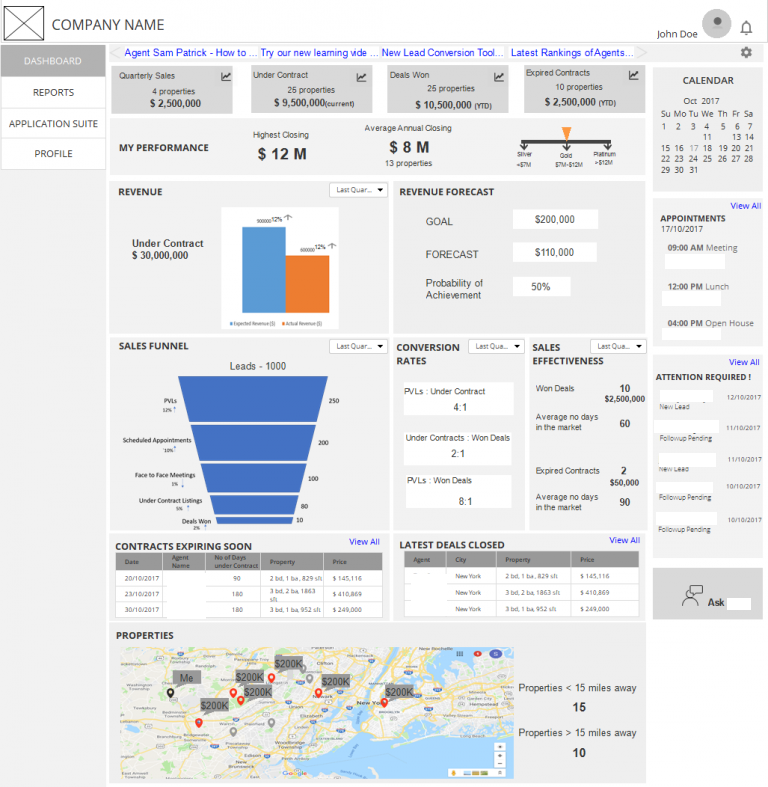
Fig 1. Wireframe of Dashboard Designed for a Real Estate Agent

Fig 2. Sample Mockup Designed for a Real Estate Agent
In the real estate industry, data is often unstructured and unaccounted. This platform allows agents to prospect leads, manage and follow up on them, view the status, close on them and ultimately account for the costs and commissions.
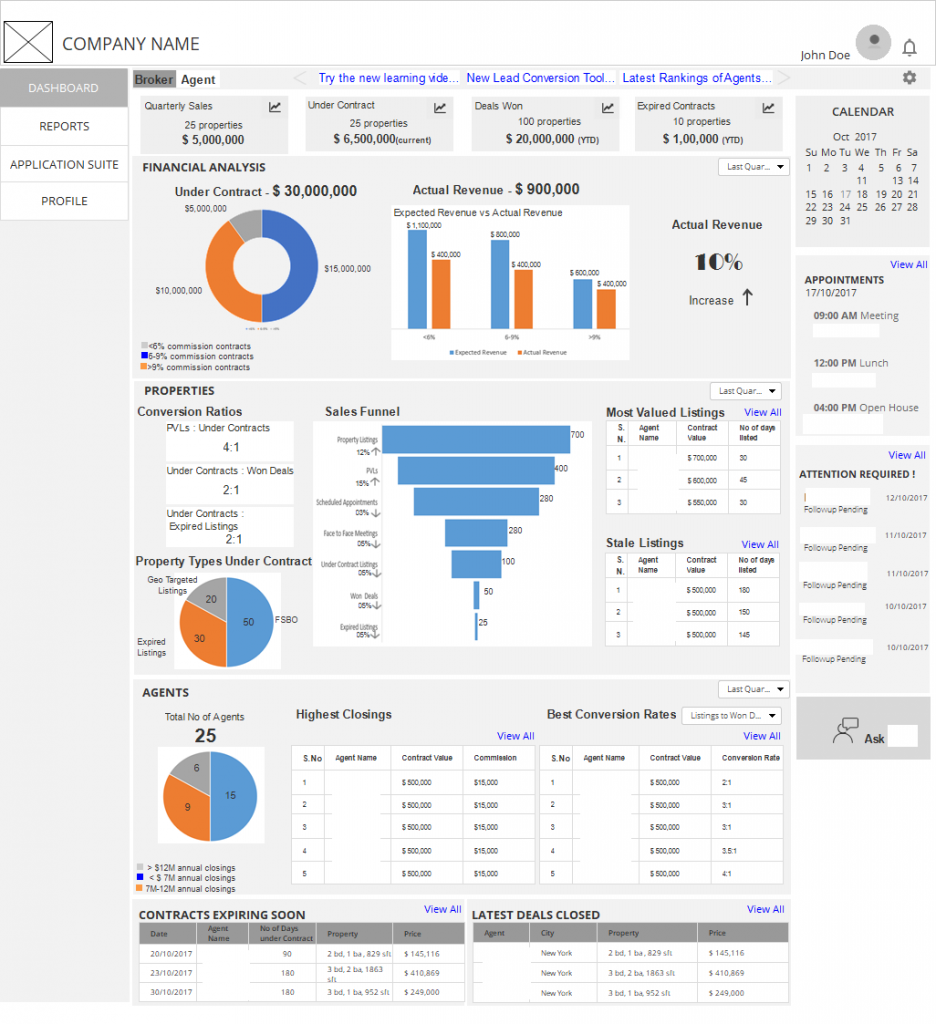
Fig 3. Wireframe of Dashboard Designed for a Real Estate Broker
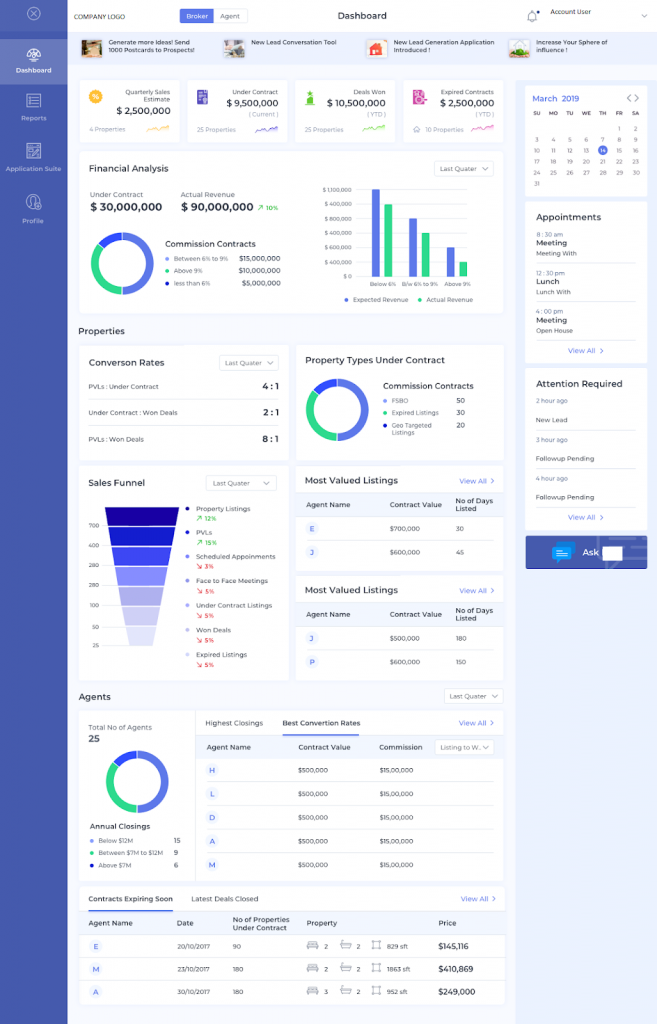
Fig 4. Mockup Template Created for a Real Estate Broker
Expectations from a Good Sales Dashboard
A well-designed sales dashboard is like a good storyteller. It tells you a story complete with the setting, the characters, the main plot, the conflicts, and a conclusion. This should all flow in a seamless, logical way as the eyes of the user move from the top of the dashboard to the bottom; gauging information, which is crucial to making accurate decisions.
Salespeople usually juggle with a lot of numbers. They have numbers related to revenue, sales pipeline, products and services, customer base, forecasts, financial data etc. These numbers help them analyze and make critical decisions on the next move to steer their business forward to success. If these numbers are all scattered around, a salesperson may end up spending precious time gathering data and in the process slip on making important decisions.
Now, imagine if all these numbers come across as a story. Accordingly, the salesperson is able to quickly view the Key Performance Indicators (KPIs) of their business, make a conclusion and plan for the next moves. That is what a good sales dashboard aims to achieve.
A good sales dashboard gives an unbiased true picture of the day to day workings of one’s business. It provides an illustrated view of KPIs and other information crucial in the sales process.
Related Read: Ok Seriously, How Important Is Data Visualization?
Besides, a well-designed sales dashboard should also offer access to real-time data. With this real-time data, salespeople can continually monitor the sales pipeline and activities for making crucial decisions.
The design is yet another leading factor in ensuring better user experience. The logical arrangement of the metrics and other information contribute to effortless navigation all the while ensuring that the most important information is accessed first.
Designing a Sales Dashboard
Now, on the other hand, designing a sales dashboard is an equally daunting task. How do we represent all those numbers in a visually pleasing and logical manner? Furthermore, which numbers to choose from the many, that would ultimately matter the most to the client.
Keeping in mind the following tips will help you design an effective sales dashboard.
1. Getting Your Story Right
A good understanding of the client’s business and its KPIs will help you build the story. Identifying the pulse of the business by tapping on which will give you a correct understanding of the business’s lifeline is the key. Following are some metrics that are generally used in sales –
-
Revenue
This is the key indicator denoting how well the business is doing. Revenue is compared over time (monthly, quarterly, yearly) or with the projected versus actual revenue. It can also be compared to the costs and expressed as a return on investment (ROI). Another way of representing it is to show profits after all the costs are deducted from the revenue. Finding out from your clients which figure would best be useful to them will help you in the design.
-
Forecast
The client can integrate a system to predict their future sales and revenue based on their past backlog, current pipeline, employee performances, market conditions etc. Showing this data on the dashboard will help them see the direction their business is taking.
-
Sales in Numbers and Value
From where is all the revenue coming? Is it from just one product or are all the departments making enough sales? These questions can be answered by displaying the sales in numbers and value. This will give more clarity on the inner workings of the client’s business.
-
Sales Pipeline
The sales pipeline reflects the number of deals in each stage of the sales process. The stages can be open leads, qualified leads, face to face meetings, proposal stage, and closed deals. The number of deals in each stage will help the salesman asses whether they have enough incoming leads to sustain their business, and also whether they have an appropriate distribution of deals to meet their sales targets. It also helps in forecasting revenue in the near future.
-
Lost Deals or Backlog
Negative metrics such as the number of lost deals or the backlog from the previous financial cycle, on the dashboard help in critical decision making. It can tell the salesman where their business is lacking and what it is that they need to focus on.
-
Conversion Ratios
Conversion ratios tell the efficiency of the various stages in the sales process. Numbers such as these – the ratio of open leads to qualified leads, the ratio of qualified leads to closed deals, the ratio of open leads to closed deals etc. help in understanding where the work is getting piled and identifying the bottlenecks faced in the business.
-
Attention Required/Overdue items
Salespeople would appreciate if they can get hold of a list of items on the dashboard, which needs their immediate attention. Overdue tasks is another area which needs to be highlighted in the day to day functioning of the business.
-
Performance
A metric that reflects the sales effectiveness or achievements of a salesperson in line with the company strategy and targets would summarize their performance and also act as a motivating factor to push them towards achieving more.
2. Making Data Comparisons for Deriving Insights
One can gather meaningful insights from data when a comparison is made. Therefore, the way these metrics get compared side by side to derive a logical conclusion is downright important.
Should the metrics be compared with respect to each other? For example actual revenue against forecasted, lost deals versus won deals, sales backlog against the pipeline etc.
Or should it be compared with respect to time? Daily, weekly, quarterly, year on year, year to date etc. Making a comparison should ultimately help the salesperson answer the right questions.
3. Building your Story on Actual Data
Getting real-time data is really helpful in determining the best way of representing it. If it is fictional data, then one must stick to keeping the proportions right. Each chart has a specific type of data that it represents. For example, a pie is used to represent parts of a whole, a funnel represents a progression and a line displays variation over time of different series.
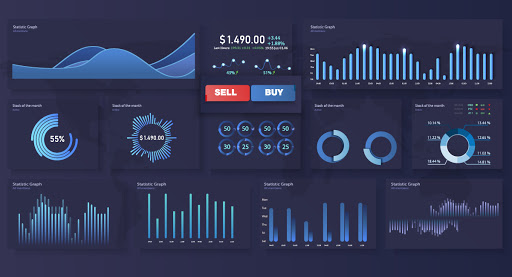
When you use actual data, you tend to realize that some charts do not look as good as you expected and maybe you should think about representing it in some other way. Or, that some numbers are better off shown as numbers itself and not compared to other figures as part of a chart, because it might end up skewing the chart in one direction.
4. Following General UI/UX Principles
Following the general UI/UX principles of good design makes the dashboard visually pleasing and easily navigable. Since most people read from left to right and top to bottom, aligning the widgets on the dashboard in the same order as the story progresses, helps in seamless navigation. The top left space on the dashboard is where the eye falls first. Placing the most important piece of information there ensures high visibility.
Leaving enough white spaces and keeping the dashboard uncluttered will help the user assimilate the information better. A sales dashboard should be concise with just the right amount of information for the salesperson to make an assessment of their business.
5. Keep Reinventing
Nobody gets it right the first time. Redesigning the dashboard a couple of times gives you a better perspective each time and helps you discover the one which will ultimately win your client’s heart.
Related Read: Make Your Data Visualization go Viral: 10 Quick Tips
Wrapping Up
Bringing things into perspective or distilling the essence from a mix of information is what a sales dashboard is all about. Companies have been relying on such visual representations to get an overview of what needs to be done. Particularly in the area of sales, such close visualizations of a range of data can indeed prove helpful for salespeople to gauge information as it is intended and make decisions crucial to the sales process. Owing to its importance, it is downright necessary to build and design a sales dashboard in accordance with certain principles.
By taking into consideration the key metrics that define the sales process, it is possible to delineate the entire workflow and pipeline to an easily identifiable visual form. Such a dashboard brings more clarity in the process, enabling salespeople to understand and apply the necessary changes. We did just that with our client by formulating an effective sales dashboard. This would ultimately help them leverage sales data to contrive practices that push their business forward, all the while accelerating efficiency and ROI.
Stay up to date on what's new

Featured Blogs
Stay up to date on
what's new



Talk To Our Experts
A workshop to get you technology-ready for business challenges
District Hall, 75 Northern Ave., Boston 6 pm, April 4th, 2019.
INFINCE is sponsoring a great opportunity for small business owners to learn new and overlooked ways they can adapt technology that lets them serve their clients better and more cost-effectively. On 4th April 2019, INFINCE is sponsoring a workshop to guide new and growing businesses to recognize tech-addressable business challenges, evaluate their implications, and to assess technological available options.
Although most businesses in today’s world are “internet companies”, yet a major portion of the small scale industry remains technologically challenged. Plenty of factors like lack of time, tight budgets, and limited infrastructure often restricts the small and medium business owners from transforming digitally. Moreover, replicating what other small businesses have done can not only be costly, but can lock a business into outmoded technology.
“Many a time small business owners turn down digital adoptions as they consider technology as too complex or too costly an affair or are unaware of the benefits they could acquire from such transitions.”
Dileep Jacob, Head of Global Delivery, Fingent.
Considering the many challenges faced by business owners today, INFINCE has pulled together this workshop to help organizations make better technological decisions for rapid business growth. The session, on 4th April 2019 from 6 PM to 8 PM in the District Hall of Boston, will include information about a variety of digital tools and solutions applicable to growing businesses.
Our objective is to better prepare the owners of small enterprises to choose and use the right technology that arms them for constant business battles; the workshop will present cost-effective and streamlined ways of organizing a firm’s IT options. Whether this is the first step towards business innovation or accommodating the needs of a growing business with changing technologies, the workshop will walk business owners through many do’s and don’ts of technology transition.
“In today’s world innovation is no longer an option but a necessity. The workshop aims at leaving attendees well informed on choosing the right digital options to solve their prevailing business situations and prepare their whole organization for a remarkable future”, said Stephen Cummings, Senior Vice President, Fingent.
The workshop – A Technology Guide For Small Business, presents a great opportunity for business owners who are making their first digital steps toward a technology future within an immensely competitive market. After the workshop, those interested will be able to have a hands-on introduction to INFINCE, a new platform designed expressly to provide small business owners control over their digital capabilities now and in the future.
For free registration sign up at: https://www.infince.com/workshop
About INFINCE
INFINCE is cloud technology optimized for small businesses and a platform to run IT without any hassles. Stephen highlighted on some of the key traits of INFINCE that makes it different from other cloud platforms. Quick deployment is one such, where a company can set up and run INFINCE within minutes. INFINCE is also economical as it integrates optimal cloud configurations that cut down cost without sacrificing on performance.
About Fingent
Fingent is a software development company, with an office in Cambridge, that develops custom software to enable our clients to operate more effectively, more efficiently, and with more resiliency. Since 2003, Fingent has developed web and mobile software solutions that have been key to our clients’ business success. Our technology and industry expertise enables us to deliver sophisticated solutions rapidly and on budget. For us, it is not only about delivering software but also about partnering and playing a part in business efforts to shape a brighter and smarter future.
Stay up to date on what's new

Featured Blogs
Stay up to date on
what's new



Talk To Our Experts
Over the past couple of years, digitization has enabled technology-driven small companies to outclass established business houses worldwide. With industries ranging from taxi-services to banking, transforming digitally, more and more enterprises are realizing the importance of making digitization their number one priority. The tech-savvy consumer base, which consists of the population below the age of 30 and covers 50% of the global population, is considered to be the key driver behind this realization. Such folks have the rising affinity to expect every business organization they interact with to provide the fastest and most satisfying experiences each time. As a business, turning deaf ears to customer’s expectations can lead to unrevivable consequences. From AI to blockchain, IoT and RPA, the list of digital innovation you need to pay attention to are huge.
It’s nearing the first quarter completion of 2019 and we thought this would be the perfect time to show you the digital innovations that we believe will reshape businesses in the coming months and future years. Here are our top 5 picks from technologies that enterprises need to watch out for by 2022:
Flexible Cloud Computing
When cloud computing became mainstream a couple of years ago, there was a rush from enterprises to build their technology competence on the cloud. This resulted in several businesses having their own private cloud ecosystems that supported their own limited digital innovations. Today, many available digital tools require a complex network of cloud resource. This has reshaped the cloud computing ecosystem which has now transitioned into intelligently connected networks that have Public, Private and Hybrid cloud partitions working in sync to help businesses derive value from technology running on these platforms.
Different IT workloads may need to be run simultaneously over multiple cloud platforms to achieve enterprise goals and this has resulted in the so-called Multicloud saga. This is one area which will see more developments and interest from the business community in 2019 as the previous year saw major cloud service providers acquiring or developing solutions to club their multiple cloud ecosystems to serve client interests.
Related Reading: Find how a cloud platform like INFINCE can help businesses leverage technologies more efficiently.
Blockchain in Mainstream
The past couple of years saw considerable investments from the business community in the blockchain. We believe there will be mainstream applications coming out in 2019 that will revolutionize areas such as data security, digital identity verification, and intelligent automation. Sectors such as BFSI, logistics, regulatory bodies, and government agencies have already started using blockchain to set up complex autonomous verification and validation systems that require minimal human intervention, thanks to the capacity of blockchain to be immutable.
In the coming years, more mainstream consumer-facing areas of businesses would be driven by blockchain based autonomous operational interfaces and it could set the stage for innovations akin to self-driving cars. Many technology companies would be coming out with mainstream solutions having blockchain essentials embedded into their core and these would further enhance business capabilities for enterprises worldwide.
Related Reading: Find how blockchain technology can transform the supply-chain industry.
Digital Modelling
While this concept has been around for a while, we think it will make more impact this year as more companies are investing in this front. The idea is to create a digital persona for every product or service business has to offer its customers. This persona would be used to arrive at choosing the right supporting digital enablers like data generators (sensors, IoT enabled devices, etc.) as well as the right decision path (data models and implementations of data science to arrive at success models). Such persona would be used to ascertain an offering’s readiness to the market, the cost required to maintain it viable, the processes and business models that need re-defining to support it and so on. The entire exercise though a bit complex will bring about a strategic advantage to adopters as their business offerings would be more aligned for digital success than competitors.
Related Reading: Digital innovation is transforming today’s business. Find how your business can benefit from digital transformation too.
Immersive Experiences
2019 will see consumer experiences moving to a more immersive phenomenon where almost everyone from a local retail shop to an e-commerce giant will offer interactive experiences courtesy of technology like augmented and virtual reality. Gartner says that by 2022, nearly 70% of all businesses would be using immersive customer experiences in some form on an experimental basis. Such immersive technology will find its way into numerous consumer-facing scenarios like demonstrations, virtual assistants, field services and so on. With gadgets supporting immersive experiences like smart glasses and wearables being available for very affordable prices, the consumer base requiring such experiences will grow tremendously in the coming years. The possibilities are limitless and businesses small or big can capitalize on this opportunity to improve their competence.
Related Reading: Check out the ongoing battle between AR and VR and find which technology has the potential to mainstream first.
Conversational Intelligence
Artificial intelligence is no longer a trend to watch out for because it has already gone mainstream over the last two years. Today, the focus should be on solutions that have been made available by harnessing the power of AI. One major solution that has gained attention now are conversational bots. From websites to major apps, a multitude of consumer-facing interactions is now handled by programmed bots that can interpret queries and respond intelligently.
Be it ordering food from a restaurant, booking a cab or even carry out a banking transaction, tech-savvy consumers are increasingly depending on personal digital assistants or bots to aid them in every step of the way. The proliferation of smart devices like smart home speakers, wearables and other IoT enabled home and personal electronic devices have created immense possibilities for a business to connect more effectively with end users. Today, you can ask your smart coffee maker to brew a coffee in the most precise variants of taste and smell without even having to touch the coffee maker. You can simply ask the personal assistant on your phone to do so.
Related Related: Find unconventional ways Artificial Intelligence is driving business value.
The top technologies mentioned above concludes that 2019 and the years to come is going to be a breakthrough year for several technological innovations. Business leaders need to hone their digital skills to keep pace with the rapidly growing market. On the positive side, most of these technology platforms or solutions come in affordable subscription basis and hence it is pretty much accessible to any enterprise despite their business size. However, the biggest differentiator for your success is the right technology advisory and implementation.
This is where our consultants at Fingent can become your best asset. With years of experience in empowering multiple businesses to achieve their digital aspirations, our world-class services can help you achieve your digital dreams seamlessly. Talk to us to know more about how we can help you embrace the above innovations and much more into your mainstream business operations.
Stay up to date on what's new

Featured Blogs
Stay up to date on
what's new



Talk To Our Experts
Despite the industry buzz over the past few years, benefits realization and simple operational stability after go-live are arguably the biggest challenges companies are facing when implementing their new ERP systems. Recently, 60% of organizations failed to realize the business benefits they expected from their ERP implementations!
Among the business management tools available today, numerous studies illustrate the key factors to consider before choosing an ERP system for your business. The “Clash of the Titans” report by Panorama Consulting summarized quantitative results from hundreds of ERP implementations across the globe. The results showed that implementing the SAP ERP system, and implementing the Oracle ERP system produced very different results for different businesses!
For instance, an Oracle customer spends less on its implementation. Compared to this, a SAP customer is able to offer an implementation timeline that is relatively close to what was forecasted to be.
Another research considered a data set of over 2000 respondents from 61 countries, to illustrate the value of the people’s respective ERP implementation. The results showed that SAP held the largest market share of three vendors, with a 22% share.
The Key Factors That Make SAP Stand Out
- SAP or Systems, Applications, and Processes deal with data planning.
- The use of SAP has been compatible with large corporations such as Microsoft and IBM. Oracle, on the other hand, stands for Object Relational Database Management Systems (ORDBMS) and can be hosted in a number of platforms.
- SAP is a business management tool that allows real-time tracking in addition to the management of sales, finance, accounting, and human resources.
- SAP does not follow the traditional information system management where each management tool is considered as an individual system that operates independently.
- SAP integrates business applications using ERP (Enterprise Resource Planning Software) and on the other hand, Oracle, an Object Relational Database Management System (ORDBMS), is used in enterprise environments.
- Development and deployment in SAP can include Oracle as a database system as it can be integrated with numerous databases.
- SAP performs with a single information pathway alone for their entire enterprise and all other common information.
- SAP applications cannot interact with their own systems but can interact with other processes in order for tangible business events to happen.
- SAP ensures easier functions of management. This includes integration and other functions.
- The SAP model runs on a programming language of the fourth generation. It is known to us as Advanced Business Application Programming (ABAP).
Related Reading: Check out how SAP HANA technology is the new game changer for industries.
On the other hand, Oracle is an Object Relational Database Management System (ORDBMS) that comes from the massive Oracle Corporation.
The Oracle Database Management System is created with at least a single instance of a particular application. These specific instances are specific processes of the operating system, also benefit the storage!
In a nutshell, the key differences between Oracle And SAP are as follows:
| SAP | Oracle |
| The highest share of the market | Highest selection rate when shortlisted |
| Highest short-listing rate | Longest implementation duration |
| Lowest selection rate when shortlisted | The highest delta between planned and real implementation time frame |
| Longest payback period | The tiniest percent of users who realized between 81- and 100-percent of its advantages |
Related Reading: Find reasons why you should use SAP and how you can plan a budget for it.
Who is King In The Area Of Business Software?
SAP and Oracle compete mainly in the areas of Business Software like ERP, CRM, and SCM. SAP is said to have more installs than Oracle in bigger companies. Let’s have a walk-through across some key reasons:
-
SAP Being The Pioneer
SAP ERP ran to the list first. SAP was already well established as a full ERP solution when Oracle was just starting to establish a Financials package for companies! By virtue of being first, SAP is well embedded in this environment.
-
A Much Better Integrated Solution
The core SAP ERP modules were built from scratch to full integration. So when a change is made, all other related modules are updated immediately. This comes useful when you extend it with a CRM or SCM functionality.
-
Mind-Share And Brand Recognition
Most companies/ people tend to have considered ERP implementation also as a status decree! They believe it increases their brand value.
-
Support Factors
SAP has a much larger pool of developers and consultants with a much larger installation base!
Read: 5 Tips For Getting The Best Out Of Your ERP System
CIO Strategies Matter! – How SAP Drives Ahead Of The Game!!
There are several case studies to validate why SAP is preferred over Oracle by many Business and CIOs. They are as follows:
-
SAP being the pioneer in ERP implementation
As SAP has been the leader and the pioneer in implementation, it preferred over Oracle with a brand value which indicates ERP leadership and preference.
-
SAP is an in-house built product
SAP was built in house. It has worked with industry experts to evolve the ERP processes and is able to build a robust solution. It allows customers to customize SAP functionality and yet get the client specific processes defined in ERP.
-
Robust integrated and scalable ERP
SAP has designed a highly integrated ERP which has world-class performance and scalable to multiple solutions. It also easies integrations with 3rd party solutions.
-
IS –Solutions
SAP has provided additional IS solutions which are optional but they allow businesses to have specialized processes on single ERP which is well integrated and reap benefits for “best industry solutions”
-
SAP Analytics
Integration on ERP and BI is notable and provides unbeatable performance and flexibility to define reports. Analytics based reporting Management to take real-time decisions
-
SAP Support services
SAP provides class support services which give Business assurance of resolution in critical situations.
-
SAP provides implementation methodology and Best practices and Tools
These tools provide a fool-proof implementation road map and reduce risks during the course of implementations. Following this guidance one can implement SAP in as less as 4 months; which means faster ROI.
SAP HANA with its “in memory” capability ensures super speed of processing data. The new UI solutions via Fiori give top class User experience.
In a nutshell, hiring the best qualified, focused and unbiased ERP can make your business more successful. So stay focused with our latest articles and blogs on SAP versus Oracle ERP implementation to go-live successfully!!
Stay up to date on what's new

Featured Blogs
Stay up to date on
what's new



Talk To Our Experts
Why is SAP HANA considered a Game-Changer?
Advanced data crunching abilities of today’s technologies are hungry for their watermark moment! The older technologies are not being dexterous enough to meet with the needs of today’s businesses. So, in February 2015, SAP released ‘Business Suite 4 SAP HANA’, or ‘SAP S/4HANA’ for short, as a replacement for its predecessor, ‘SAP R/3’ and ‘Business Suite’ platforms.
This change will not only affect their existing clients but also the systems integrators (SIs) because they have built their businesses by promoting firms adopt and customize SAP applications!
In-Memory Technology of SAP HANA – The Game Changer
S4/HANA will run on the SAP HANA database platform alone. The previous enterprises could prefer databases from other vendors such as Microsoft, Oracle, and IBM. SAP HANA is considered much more innovative in functionality than its older version. Let’s find why exactly SAP HANA is considered the game changer!!
Related Reading: Learn why should you choose SAP and how you can plan your budget for it.
What Makes SAP HANA Create A Material Difference To Business Success?
HANA is a High-Performance Analytic Appliance. It is an in-memory platform for processing high chunks of transactional and operational data in real time. The in-memory technology provides prompt responses to queries without any waiting time. This is considered a game changer in the industry as the whole database is stored on the server memory for real-time analysis. The processing is with the data stored in disks where analysis is done in increments via redundant disk read-write activity.
According to SAP, adoption trends of SAP HANA by clients is constantly mounting across multiple industries with already 6400+ customers using this platform. This number is likely to grow in the year, according to SAP.
- Rapid forecasting and business strategy development without delays
- Business performance can be monitored better in real time
- Improved marketing campaigns through data analytics
- Prevent unplanned disruptions and avoid risks in business operations
- Accurate business decision making.
Time To Enable Some real-time functionality to analytics – SAP HANA does it ALL!
Enabling real-time functionality to analytics, business applications and data services are the highest priorities of CIOs. SAP HANA is the biggest, game-changing technology to impact these initiatives.
Key business drivers for SAP HANA adoption
- Real-time Analytics and Dashboards – SAP HANA permits information to be displayed dynamically without the need for aggregation. It can be presented in different dimensions for decision making and also for verifying business progress. Using real-time or historical data with prebuilt predictive libraries, analytics can be performed well.
- Data warehousing – Streamlining of data is important for better management. SAP HANA does this by offering predictive analytics. Thus trends are identified and it becomes easier to take better decisions on business strategies.
- Optimized Business Functions – SAP HANA runs with the in-memory technology that accelerates application performance. It helps in providing real-time reporting and also in offering BI tools. SAP HANA can run complex ERP or MRP applications to customize information using real-time data. This is how the firms that use SAP HANA are able to act promptly and adapt to changing business requirements or the latest market trends!
- Big data Rules – Gaining business insights and targeting clients with personalized offerings is the prime motive for any business. Big data analytics is used for the same. For this, HANA suite offers big data development and analytics tools.
- Swift And Accurate Decision Making With Automation Advances – Advanced analytics feature in SAP HANA can be used to transform business insights into actions for swift and accurate decision making in businesses.
Adoption Of SCRUM Framework – SAP HANA is Undoubtedly A Game Changer
SAP has adopted SCRUM as the framework and this helps in performing operations in short, iterative cycles.
SCRUM uses ‘time-boxed’ iterations. These iterations are termed “sprints. The objective of every sprint is to build a tested, workable piece of the system, that is ready to be released to production. These iterative cycles are based on the ‘Lean’ principles of software development. This helps in carrying out detailed analytics in real-time and on a transactional system directly. This is exactly why in-memory computing and SAP HANA are termed game changers because they function with such a powerful framework. This platform also provides a package for integrating multiple data sources. It also helps to perform various types of analytics that is, predictive, spatial, text, and so on. It can run simultaneously with SAP ERP software where analysts can access real-time transactional data instead of waiting to run daily or weekly reports.
Related Reading: Confused between Odoo CRM and SAP CRM? Learn how to make the right choice.
SAP HANA To Provide Real-Time Access To Business
Eliminating duplicate data and expensive data storage and improving query performance are features provided by SAP HANA along with real-time data analytics and support for end-user adoption. HANA Enterprise provides the most value and flexibility for higher BI solutions along with providing solutions for organizations that have a lot of non-SAP data, need real-time replication or require complex data transformation, cleansing or merging,
SAP HANA does not need additional software for data access. HANA Enterprise enables business users to immediately access their analytical data in real time, in a single environment, without affecting existing applications.
SAP HANA Technology – The Economic Impact
With the cost-saving efficiencies of SAP HANA, the software development costs for enterprises reduced by almost 70%, administration costs reduced by over 20% and hardware spending reduced by 15%. Thus, SAP HANA is clearly proving to benefit organizations in both ways, that is, to business and technology.
SAP discloses that the adoption of S/4HANA has doubled year over year to more than 5,400 customers as it published its full-year financial results.
With its potential to process large chunks of data in server memory by combing the capabilities of database, data-processing and application platform execution. SAP HANA is considered to be the next major breakthrough in enterprise IT.
All of us in IT are aware that better business decisions are made only when data is available in a meaningful format and at the right time. It is time to extract the benefits out of SAP HANA for successful business execution. Keep your eyes clapped on our latest articles about SAP HANA to learn more!!
Stay up to date on what's new

Featured Blogs
Stay up to date on
what's new
















